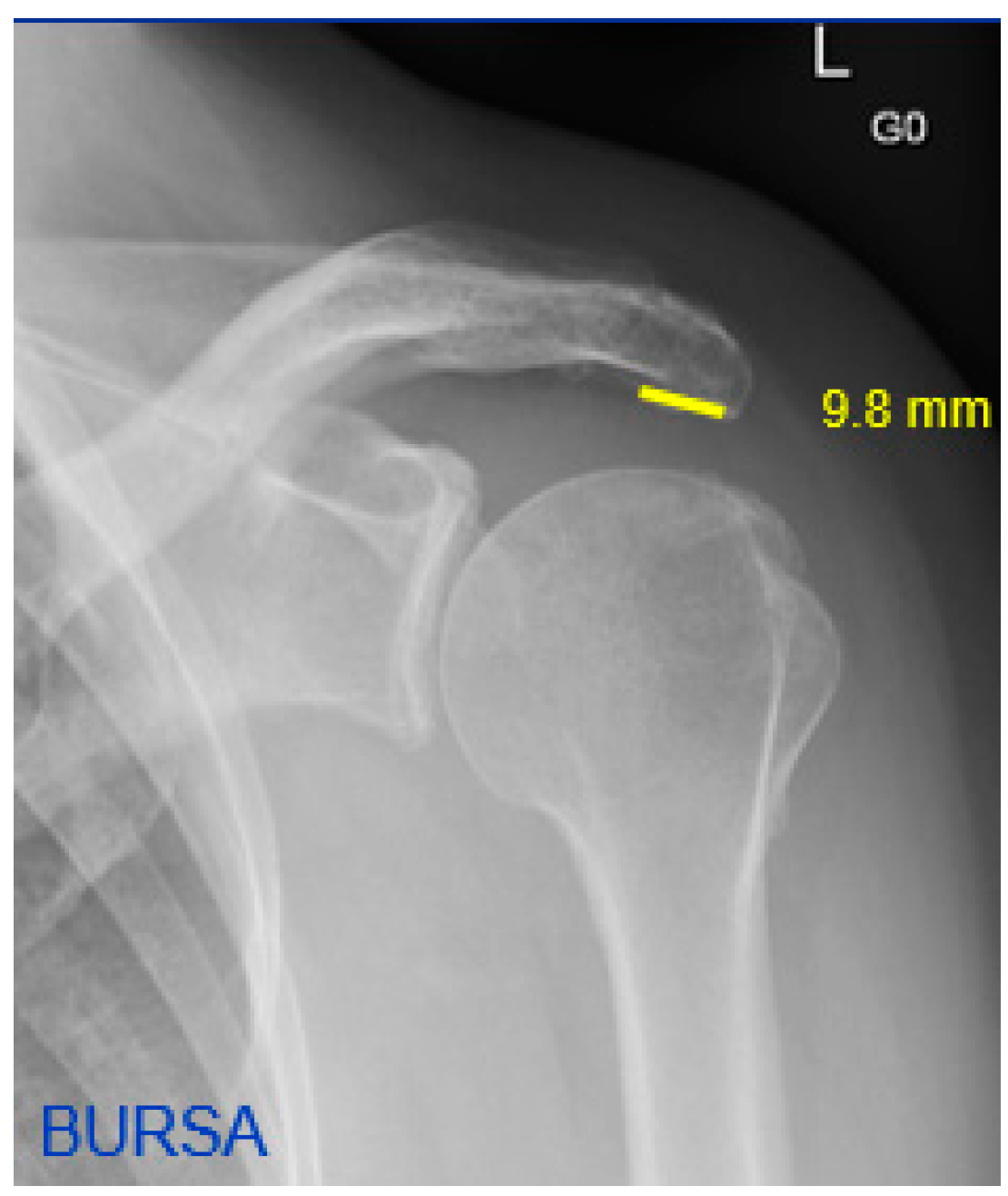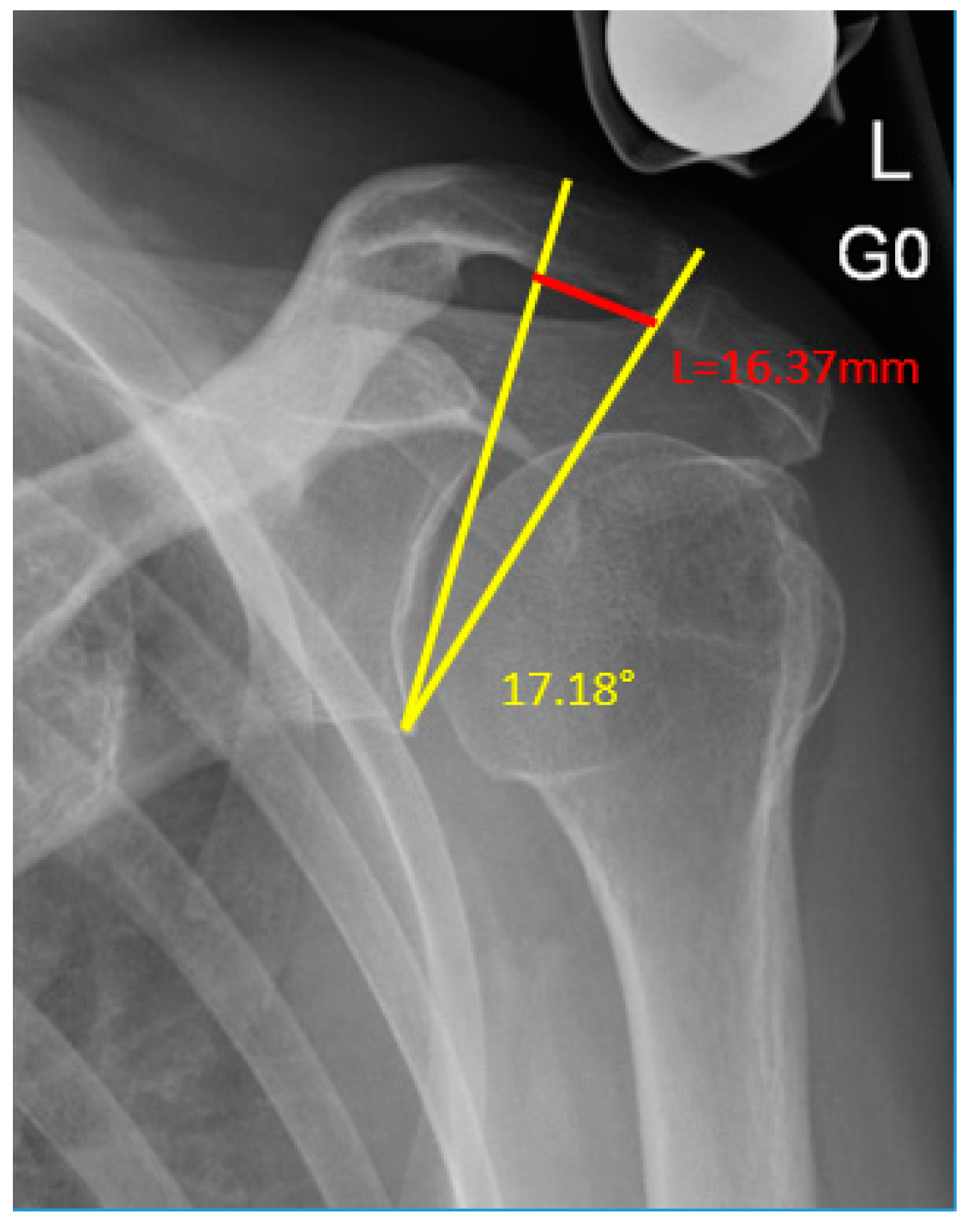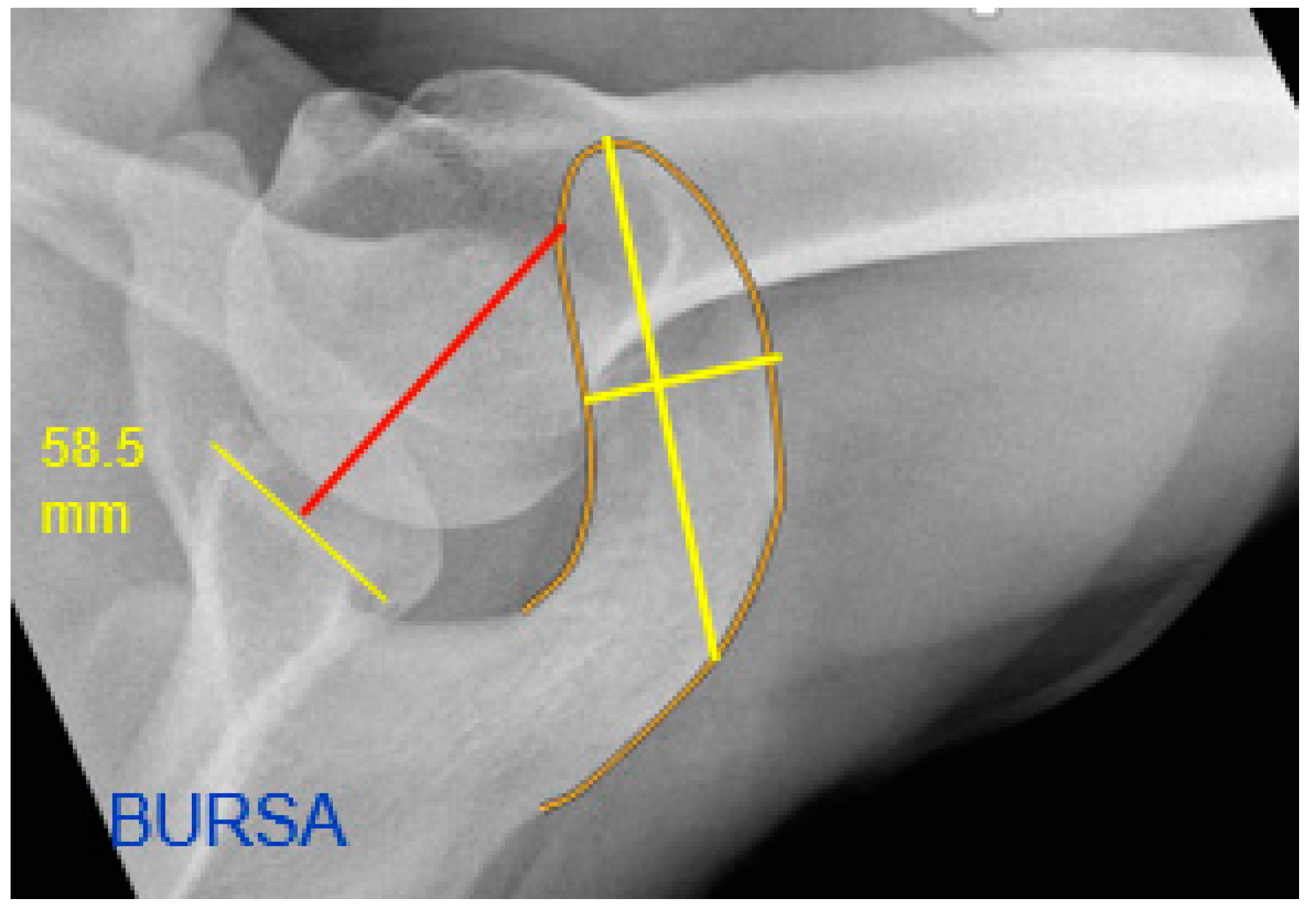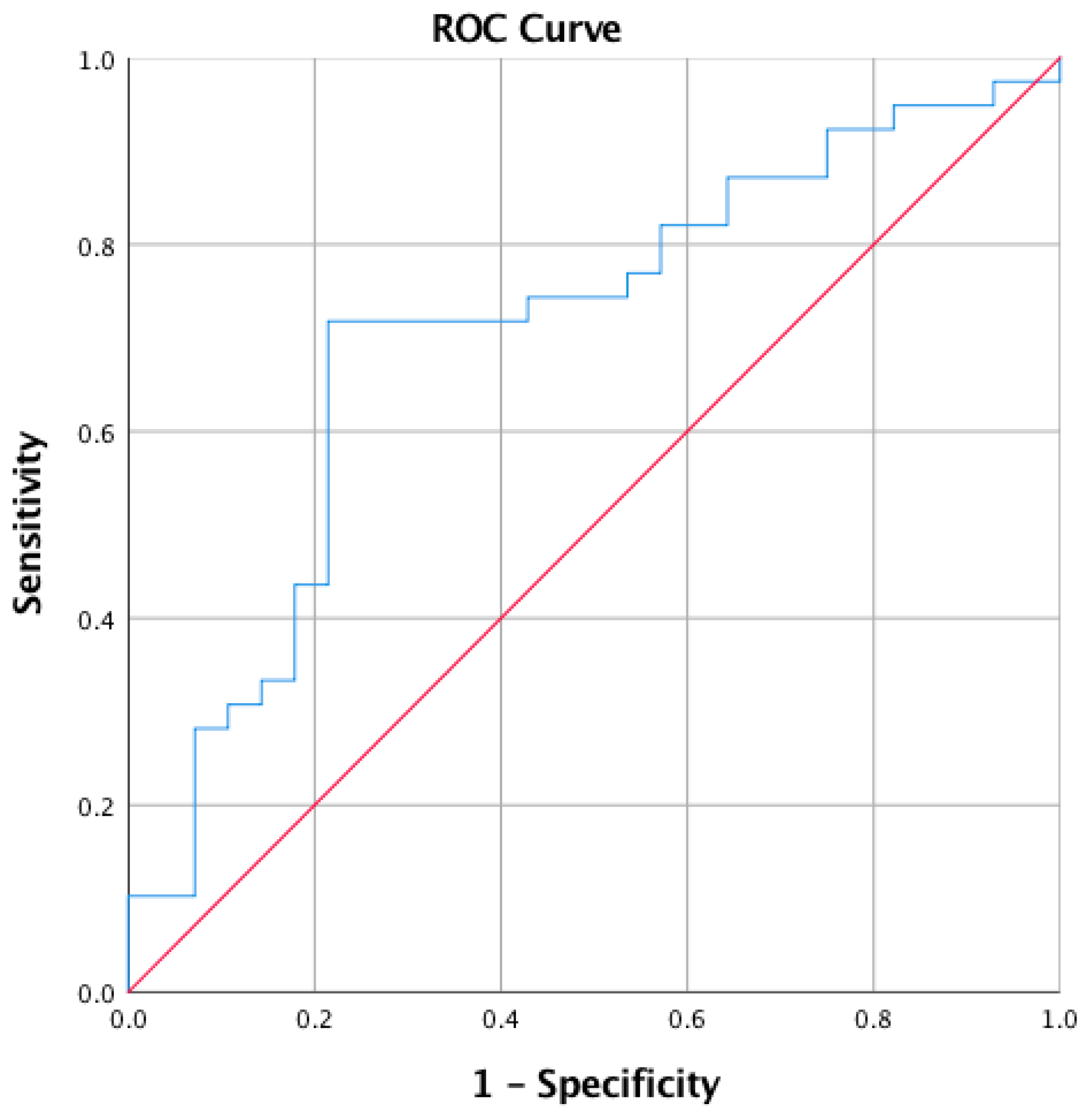Acromial Morphology and Its Relation to the Glenoid Is Associated with Different Partial Rotator Cuff Tear Patterns
Abstract
1. Introduction
2. Materials and Methods
2.1. Radiographic Measurements
2.2. Reliability of Radiographic Measurements
2.3. Data Processing and Statistical Analysis
3. Results
4. Discussion
5. Conclusions
Author Contributions
Funding
Institutional Review Board Statement
Informed Consent Statement
Data Availability Statement
Conflicts of Interest
References
- Neer, C.S., 2nd. Anterior acromioplasty for the chronic impingement syndrome in the shoulder: A preliminary report. J. Bone Jt. Surg. Am. 1972, 54, 41–50. [Google Scholar] [CrossRef]
- Frank, J.M.; Chahal, J.; Frank, R.M.; Cole, B.J.; Verma, N.N.; Romeo, A.A. The role of acromioplasty for rotator cuff problems. Orthop. Clin. N. Am. 2014, 45, 219–224. [Google Scholar] [CrossRef] [PubMed]
- Budoff, J.E.; Nirschl, R.P.; Guidi, E.J. Debridement of partial-thickness tears of the rotator cuff without acromioplasty. Long-term follow-up and review of the literature. J. Bone Jt. Surg. Am. 1998, 80, 733–748. [Google Scholar] [CrossRef] [PubMed]
- Lohr, J.F.; Uhthoff, H.K. The microvascular pattern of the supraspinatus tendon. Clin. Orthop. Relat. Res. 1990, 254, 35–38. [Google Scholar] [CrossRef]
- Sano, H.; Ishii, H.; Trudel, G.; Uhthoff, H.K. Histologic evidence of degeneration at the insertion of 3 rotator cuff tendons: A comparative study with human cadaveric shoulders. J. Shoulder Elb. Surg. 1999, 8, 574–579. [Google Scholar] [CrossRef]
- Moor, B.K.; Bouaicha, S.; Rothenfluh, D.A.; Sukthankar, A.; Gerber, C. Is there an association between the individual anatomy of the scapula and the development of rotator cuff tears or osteoarthritis of the glenohumeral joint?: A radiological study of the critical shoulder angle. Bone Jt. J. 2013, 95B, 935–941. [Google Scholar] [CrossRef]
- Moor, B.K.; Rothlisberger, M.; Muller, D.A.; Zumstein, M.A.; Bouaicha, S.; Ehlinger, M.; Gerber, C. Age, trauma and the critical shoulder angle accurately predict supraspinatus tendon tears. Orthop. Traumatol. Surg. Res. 2014, 100, 489–494. [Google Scholar] [CrossRef]
- Nyffeler, R.W.; Werner, C.M.; Sukthankar, A.; Schmid, M.R.; Gerber, C. Association of a large lateral extension of the acromion with rotator cuff tears. J. Bone Jt. Surg. Am. 2006, 88, 800–805. [Google Scholar] [CrossRef]
- Viehofer, A.F.; Gerber, C.; Favre, P.; Bachmann, E.; Snedeker, J.G. A larger critical shoulder angle requires more rotator cuff activity to preserve joint stability. J. Orthop. Res. 2016, 34, 961–968. [Google Scholar] [CrossRef]
- Gerber, C.; Snedeker, J.G.; Baumgartner, D.; Viehofer, A.F. Supraspinatus tendon load during abduction is dependent on the size of the critical shoulder angle: A biomechanical analysis. J. Orthop. Res. 2014, 32, 952–957. [Google Scholar] [CrossRef]
- Gartsman, G.M.; Khan, M.; Hammerman, S.M. Arthroscopic repair of full-thickness tears of the rotator cuff. J. Bone Jt. Surg. Am. 1998, 80, 832–840. [Google Scholar] [CrossRef] [PubMed]
- Hawkins, R.J.; Misamore, G.W.; Hobeika, P.E. Surgery for full-thickness rotator-cuff tears. J. Bone Jt. Surg. Am. 1985, 67, 1349–1355. [Google Scholar] [CrossRef]
- MacDonald, P.; McRae, S.; Leiter, J.; Mascarenhas, R.; Lapner, P. Arthroscopic rotator cuff repair with and without acromioplasty in the treatment of full-thickness rotator cuff tears: A multicenter, randomized controlled trial. J. Bone Jt. Surg. Am. 2011, 93, 1953–1960. [Google Scholar] [CrossRef] [PubMed]
- Mardani-Kivi, M.; Karimi, A.; Keyhani, S.; Hashemi-Motlagh, K.; Saheb-Ekhtiari, K. Rotator Cuff Repair: Is there any role for acromioplasty? Phys. Sportsmed. 2016, 44, 274–277. [Google Scholar] [CrossRef] [PubMed]
- Cheng, C.; Chen, B.; Xu, H.; Zhang, Z.; Xu, W. Efficacy of concomitant acromioplasty in the treatment of rotator cuff tears: A systematic review and meta-analysis. PLoS ONE 2018, 13, e0207306. [Google Scholar] [CrossRef]
- Beard, D.J.; Rees, J.L.; Cook, J.A.; Rombach, I.; Cooper, C.; Merritt, N.; Shirkey, B.A.; Donovan, J.L.; Gwilym, S.; Savulescu, J.; et al. Arthroscopic subacromial decompression for subacromial shoulder pain (CSAW): A multicentre, pragmatic, parallel group, placebo-controlled, three-group, randomised surgical trial. Lancet 2018, 391, 329–338. [Google Scholar] [CrossRef]
- Fukuda, H.; Hamada, K.; Yamanaka, K. Pathology and pathogenesis of bursal-side rotator cuff tears viewed from en bloc histologic sections. Clin. Orthop. Relat. Res. 1990, 254, 75–80. [Google Scholar] [CrossRef]
- Ozaki, J.; Fujimoto, S.; Nakagawa, Y.; Masuhara, K.; Tamai, S. Tears of the rotator cuff of the shoulder associated with pathological changes in the acromion. A study in cadavera. J. Bone Jt. Surg. Am. 1988, 70, 1224–1230. [Google Scholar] [CrossRef]
- Bouaicha, S.; Hoch, A.; Jentzsch, T.; Moor, B.K. Impact of vertical and horizontal malrotation on measurements of anteroposterior radiographs of the scapula: Need for standardized images in modern omometry. J. Shoulder Elb. Surg. 2018, 27, 659–666. [Google Scholar] [CrossRef]
- Bigliani, L.; Morrison, D.; April, E. The morphology of the acromion and its relationship to rotator cuff tears. Orthop. Trans. 1986, 10, 228. [Google Scholar]
- Dietrich, T.J.; Peterson, C.K.; Brunner, F.; Hodler, J.; Puskas, G.J.; Pfirrmann, C.W. Imaging-guided subacromial therapeutic injections: Prospective study comparing abnormalities on conventional radiography with patient outcomes. AJR Am. J. Roentgenol. 2013, 201, 865–871. [Google Scholar] [CrossRef] [PubMed]
- Dietrich, T.J.; Moor, B.K.; Puskas, G.J.; Pfirrmann, C.W.; Hodler, J.; Peterson, C.K. Is the lateral extension of the acromion related to the outcome of shoulder injections? Eur. Radiol. 2015, 25, 267–273. [Google Scholar] [CrossRef] [PubMed]
- Liu, C.T.; Miao, J.Q.; Wang, H.; An Ge, H.; Wang, X.H.; Cheng, B. The association between acromial anatomy and articular-sided partial thickness of rotator cuff tears. BMC Musculoskelet. Disord. 2021, 22, 760. [Google Scholar] [CrossRef] [PubMed]
- Panni, A.S.; Milano, G.; Lucania, L.; Fabbriciani, C.; Logroscino, C.A. Histological analysis of the coracoacromial arch: Correlation between age-related changes and rotator cuff tears. Arthroscopy 1996, 12, 531–540. [Google Scholar] [CrossRef]
- Bozkurt, M.; Akkaya, M.; Gursoy, S.; Isik, C. Augmented Fixation With Biodegradable Subacromial Spacer After Repair of Massive Rotator Cuff Tear. Arthrosc. Tech. 2015, 4, e471–e474. [Google Scholar] [CrossRef][Green Version]
- Familiari, F.; Gonzalez-Zapata, A.; Ianno, B.; Galasso, O.; Gasparini, G.; McFarland, E.G. Is acromioplasty necessary in the setting of full-thickness rotator cuff tears? A systematic review. J. Orthop. Traumatol. 2015, 16, 167–174. [Google Scholar] [CrossRef]
- Yu, E.; Cil, A.; Harmsen, W.S.; Schleck, C.; Sperling, J.W.; Cofield, R.H. Arthroscopy and the dramatic increase in frequency of anterior acromioplasty from 1980 to 2005: An epidemiologic study. Arthroscopy 2010, 26, S142–S147. [Google Scholar] [CrossRef]
- Pandey, V.; Vijayan, D.; Tapashetti, S.; Agarwal, L.; Kamath, A.; Acharya, K.; Maddukuri, S.; Willems, W.J. Does scapular morphology affect the integrity of the rotator cuff? J. Shoulder Elb. Surg. 2016, 25, 413–421. [Google Scholar] [CrossRef]
- Barber, F.A. Coplaning of the acromioclavicular joint. Arthroscopy 2001, 17, 913–917. [Google Scholar] [CrossRef]






| Position | Medial Offset (in mm) | % Change | Ratio Width/Length |
|---|---|---|---|
| Neutral | 223 | 0 | 0.59 |
| 5° Flex | 212 | −4.9 | 0.57 |
| 10° Flex | 184 | −17.5 | 0.58 |
| 15° Flex | 144 | −35.4 | 0.55 |
| 5° Ext | 229 | 2.7 | 0.6 |
| 10° Ext | 243 | 9 | 0.61 |
| 15° Ext | 272 | 22 | 0.61 |
| 0° Add/Abd | 121 | 0 | 0.45 |
| 5° Add | 135 | 11 | 0.48 |
| 10° Add | 165 | 36 | 0.47 |
| 15° Add | 240 | 98 | 0.42 |
| 5° Abd | 133 | 9 | 0.49 |
| 10° Abd | 128 | 5 | 0.49 |
| 15° Abd | 125 | 3 | 0.49 |
| PASTA (SD), n = 46 | BURSA (SD) n = 36 | p-Value | |
|---|---|---|---|
| Male/Female | 25/21 | 17/11 | 0.64 |
| Mean Age [years] | 53 (15.29) | 57 (16.02) | 0.95 |
| CSA [°] | 33.73 (3.67) | 34.56 (4.46) | 0.062 |
| Acromion Index | 0.72 (0.09) | 0.73 (0.08) | 0.44 |
| Ratio Width to Length of Acromion | 0.48 (0.07) | 0.44 (0.06) | 0.021 |
| Medial Acromial Border Offset [mm] | 40.89 (9.20) | 45.16 (8.89) | 0.021 |
| Short Sclerotic Line [mm] | 16.25 (5.02) | 13.09 (3.98) | 0.008 |
| ACOA [°] | 11.76 (4.9) | 12.72 (3.75) | 0.35 |
| AC Offset [mm] | 11.7 (4.94) | 12.78 (3.77) | 0.29 |
Disclaimer/Publisher’s Note: The statements, opinions and data contained in all publications are solely those of the individual author(s) and contributor(s) and not of MDPI and/or the editor(s). MDPI and/or the editor(s) disclaim responsibility for any injury to people or property resulting from any ideas, methods, instructions or products referred to in the content. |
© 2022 by the authors. Licensee MDPI, Basel, Switzerland. This article is an open access article distributed under the terms and conditions of the Creative Commons Attribution (CC BY) license (https://creativecommons.org/licenses/by/4.0/).
Share and Cite
Borbas, P.; Hartmann, R.; Ehrmann, C.; Ernstbrunner, L.; Wieser, K.; Bouaicha, S. Acromial Morphology and Its Relation to the Glenoid Is Associated with Different Partial Rotator Cuff Tear Patterns. J. Clin. Med. 2023, 12, 233. https://doi.org/10.3390/jcm12010233
Borbas P, Hartmann R, Ehrmann C, Ernstbrunner L, Wieser K, Bouaicha S. Acromial Morphology and Its Relation to the Glenoid Is Associated with Different Partial Rotator Cuff Tear Patterns. Journal of Clinical Medicine. 2023; 12(1):233. https://doi.org/10.3390/jcm12010233
Chicago/Turabian StyleBorbas, Paul, Rebecca Hartmann, Christine Ehrmann, Lukas Ernstbrunner, Karl Wieser, and Samy Bouaicha. 2023. "Acromial Morphology and Its Relation to the Glenoid Is Associated with Different Partial Rotator Cuff Tear Patterns" Journal of Clinical Medicine 12, no. 1: 233. https://doi.org/10.3390/jcm12010233
APA StyleBorbas, P., Hartmann, R., Ehrmann, C., Ernstbrunner, L., Wieser, K., & Bouaicha, S. (2023). Acromial Morphology and Its Relation to the Glenoid Is Associated with Different Partial Rotator Cuff Tear Patterns. Journal of Clinical Medicine, 12(1), 233. https://doi.org/10.3390/jcm12010233






